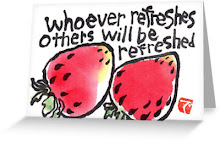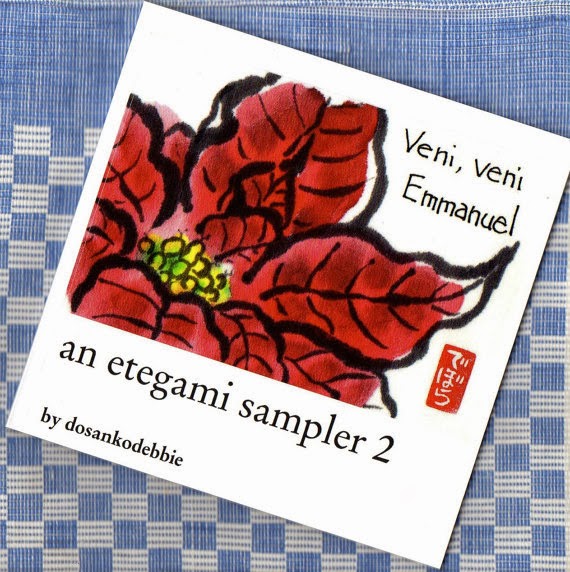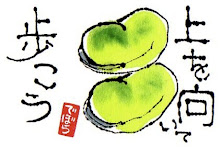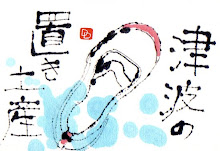"Various physical disabilities keep me housebound for most of the year, but thanks to postage stamps, a part of me is able to fly all over the world and visit with people who visit me back in the same way. This is how I feel about Etegami, Japan’s version of mail art. Even without a common language, my hand-painted cards speak to the recipient on my behalf. Postage stamps are my wings."
Saturday, April 25, 2015
i cannot walk but i can fly
"Various physical disabilities keep me housebound for most of the year, but thanks to postage stamps, a part of me is able to fly all over the world and visit with people who visit me back in the same way. This is how I feel about Etegami, Japan’s version of mail art. Even without a common language, my hand-painted cards speak to the recipient on my behalf. Postage stamps are my wings."
Wednesday, April 22, 2015
interviewed on postcrossing
I had the honor of being interviewed by Ana Campos on the Postcrossing blog, and the even greater honor of having other postcrossers actually read the article and comment on it. I'd been a little discouraged by all the postcrossing profiles that specifically state a reluctance to receive art cards or handmade cards. In fact, so many of the names that Postcrossing "picked out of the hat" for me were anti-art-card people, that I'd started having doubts about my fittedness for the group. But I was ENORmously encouraged to find out that there are more postcrossers who like art cards-- even handmade art cards-- than I had imagined. I'm feeling all motivated again and will be picking up my pace of sending out cards. Here's the link to the interview.
Tuesday, April 21, 2015
sansai recipes published
This is my third center-page feature in the Japan Times ST, and the second in a series of four-course etegami recipes sharing the same seasonal ingredient. The theme of this set is spring sansai, which includes the young leaves, shoots, and buds of several edible wild plants. You may remember that I posted a photo of the actual etegami in my March 20 post.
The word-image balance of this set is an improvement over the first set, which featured lily bulbs and was published in January. But the hand-written text still takes up more space than I like, so my goal is to simplify future layouts even more. The summer menu is due by late June, and the ingredient I've chosen for that set of recipes is umeboshi (salt-pickled ume, which are often translated plum, but are actually a kind of apricot). I do so enjoy this kind of work! (happy sigh)
Sunday, April 19, 2015
monday magic
Last week I made a new, and very young friend through Postcrossing. She reached out to me by email from her sick bed and is in terrible pain-- although I didn't find this out until later. I promised to send her a "surprise" if she would first send me a hand-drawn card, even if all she could draw was a stick figure. She wrote back to say she would try, and later she told me that concentrating on making the card had helped her to forget her pain for a while. The magic of etegami.
I eagerly wait for my husband to pick up the mail on his way home from work every evening, but her card hasn't arrived yet. Soon. Maybe today! Making etegami is magical. But waiting for an etegami that you know is on its way is magical too.
Thursday, April 16, 2015
a world of dew
I quote Kobayashi Issa (1763-1828) in the etegami on the left. His life was full of severe poverty and great physical hardship, yet his haiku reveals an attachment to the world in spite of its cruelties. He wrote this particular haiku after his baby daughter died of smallpox. I took the liberty of adding a commentary to bind the haiku to my image. But I think Issa, who had a wonderful sense of humor, would have approved.
In regard to the second card, I have to say that the saying "working for chicken feed" has always amused me, all the more because it accurately describes huge blocks of my own life. This combination of words and images is intended for some very special people in my life.
Wednesday, April 15, 2015
wishes and prayers and paper cranes
Of the dozens and dozens of origami (the Japanese art of paper folding) models I used to amuse myself with as a child, the only one I make time for with any regularity these days is the paper crane. This is because of what the crane symbolizes and the role of paper cranes in many aspects of Japanese life even now. Cranes can represent long life, fidelity, happiness, prosperity, health, healing and peace. They are a part of Japanese legend, and folded paper cranes are often used as charms for making wishes come true.
Friends and family may cooperate to fold one thousand small paper cranes and string them together to celebrate happy occasions such as a wedding or the birth of a child. In this form they are called senbazuru. Senbazuru are also made for the sick, with wishes for healing; and offered to the spirits of those killed in accidents or in times of war, as a prayer for peace.
 Although I don't believe paper cranes have any power to grant wishes, I am drawn to the sentiments they represent. So I fold them or I paint them, and I give them to people who understand without my saying so that I hold them in my heart and in my prayers.
Although I don't believe paper cranes have any power to grant wishes, I am drawn to the sentiments they represent. So I fold them or I paint them, and I give them to people who understand without my saying so that I hold them in my heart and in my prayers. Monday, April 13, 2015
raising etegami chickens
My sister and her husband have been building an earthship in rural Colorado. If you've never heard of an earthship, make sure you google the word or click the link above. Everything about their home and style of living fascinates me. Now they have started raising chickens-- one step toward a delightful collection of livestock that she dreams of raising on their property.
The chickens shown here are actually someone else's chickens, but I hope to paint hers too one of these days. This is as close as I will ever get to raising chickens myself. I'm planning to print up a bunch of these etegami before adding any words, so that I can add words later--to the prints-- in the language and sentiment suited to each recipient. The originals will eventually get mailed too, or listed on my Etsy shop.
Thursday, April 2, 2015
stamps you'll want to lick
UPPERCASE magazine comes up with jillions of interesting art projects and calls-for-submission, but rarely do the calls overlap with my limited skills and not-so-limited interests to the extent that I go beyond just thinking of participating.
This month, however, UPPERCASE has a couple of postage-stamp-related calls on offer---and you know how much I love artistic postage stamps. So, this time, I'm not just thinking about submitting, I'm actually thinking really hard.
But all I have so far is a vague idea that celebrates the 2014 UNESCO decision to register traditional Japanese cuisine as an Intangible Cultural Heritage. Oops, I remembered to write in the country name, but I forgot to include a denomination (value) for the stamps..... Hmm, must add it later or do it over.
The call description says:
Design or Illustrate your ideal postage stamp! What would be the perfect topic? What style? Typographic or illustrative? Vintage-inspired or modern? What country (real or imagined)?
Whether I end up submitting work or not, it will be very cool to see what other people create for this call. If you'd like to submit a design of your own, read the submission details (size, deadline, how to submit, etc) at this link.
PS: don't let my photo confuse you; submit your stamp design in the correct dimensions and without perforations.
Subscribe to:
Posts (Atom)





































